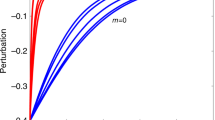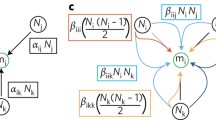Summary
The classification of interspecific interactions can have an important impact on ecologists' world views. Previous classifications have often been incomplete, have suffered from ambiguously defined categories, and/or have wrongly equated categories of population level effects with particular mechanisms of interaction. I use several simple mathematical models to argue that effects on short-term population growth rate, long term population size, and short term relative fitness of interactants may differ qualitatively. Equating all (--) effects with competition and all (+-) effects with predation may have caused ecologists to ignore a variety of potentially important interaction mechanisms. Failure to define the type of effect used in classifying interactions has led to confusion about the nature of interactions; several controversies regarding competition have apparently been caused or exaccerbated by problems with definition or clasification. In applying classification schemes, ecologists should realize that the classification of an interaction between two populations may change with the sizes of those populations or of other populations with which they interact.
Similar content being viewed by others
References
Abrams PA (1982) Functional responses of optimal foragers. Am Nat 120:382–390
Abrams PA (1984) Foraging time optimization and interactions in food webs. Am Nat 124:80–96
Abrams PA (1987) Indirect interactions between species that share a predator: varieties of indirect effects. In: Kerfoot WC, Sih A (eds) Predation: direct and indirect impacts on aquatic communities. University Press of New England, Dartmouth pp 38–54
Addicott JF (1986) On the population consequences of mutualism. In: Diamond J, Case TJ (eds) Community Ecology. Harper and Row, New York pp 425–436
Andrewartha HG, Birch C (1984) The Ecological Web. University of Chicago Press, Chicago
Arthur WA (1982) Evolutionary consequences of interspecific competition. Adv Ecol Res 12:127–187
Begon M, Harper, JL, Townsend CR (1986) Ecology: individuals, populations, and communities. Sinauer, Sunderland, Mass.
Bender EA, Case TJ, Gilpin ME (1984) Perturbation experiments in community ecology; theory and practice. Ecology 65:1–13
Boucher DH (ed) (1985) The biology of mutualism. Oxford University Press, New York
Boucher DH, James S, Keeler KH (1982) The ecology of mutualism. Ann Rev Ecol Syst 13:315–347
Brown JH, Gibson AC (1983) Biogeography. C.V. Mosby. St. Louis
Brown JH, Davidson DW, Munger JC, Inouye, RS (1986) Experimental community ecology: the desert granivore system. In: Diamond J, Case TJ (eds) Community Ecology. Harper and Row, New York pp 41–61
Connell JH (1975) Some mechanisms producing structure in natural communities: A model and evidence from field experiments. In: Cody ML, Diamond J (eds) Ecology and evolution of communites. Harvard University Press, Cambridge
Connell JH (1983) On the prevalence and relative importance of interspecific competition: evidence from field experiments. Am Nat 122:661–696
Diamond J, Case TJ (eds) (1986a) Community ecology. Harper and Row, New York
Diamond J, Case TJ (1986b) Overview: Introductions, extinctions, exterminations, and invasions. In: Diamond J, Case TJ (eds) Community Ecology. Harper and Row, New York pp 65–79
Futuyma DJ (1979) Evolutionary biology. Sinauer, Sunderland, Mass.
Haskell EF (1947) A natural classification of societies. N.Y. Acad Sci Trans Series 29:186–196
Hedrick PW (1984) Population biology. Jones and Bartlett, Boston
Holt RD (1977) Predation, apparent competition and the structure of prey communities. Theo Pop Biol 12:197–229
Krebs CJ (1985) Ecology: the experimental study of distribution and abundance. 3rd ed. Harper and Row, New York
Lawlor LR (1979) Direct and indirect effects of n-species competition. Oecologia (Berlin) 43:355–364
Leary RA (1985) Interaction theory in forest ecology and management. Martinus Nijhoff/Dr. W. Junk Publishers, Dordrecht
Levine SH (1976) Competitive interactions in ecosystems. Am Nat 110:903–910
Levins R (1975) Evolution in communities near equilibrium. In: Cody ML, Diamond JM (eds) Ecology and evolution of communities. Harvard University Press, Cambridge, Mass. pp 16–50
Lidicker WZ Jr. (1979) A clarification of interactions in ecological systems. Bioscience 29:475–477
Mattson WJ, Adey ND (1975) Phytophagous insects as regulators of forest primary production. Science 190:515–522
May RM (1973) Stability and complexity in model ecosystems. Princeton University Press, Princeton, N.J.
May RM (ed) (1981) Theoretical ecology: principles and applications. 2nd ed. Blackwell Scientific, Oxford
McNaughton SJ, Wolf L (1979) General Ecology, 2nd ed. Holt, Rinehart and Winston, New York
Moulton MP, Pimm SL (1986) The extent of competition in shaping an introduced avifauna. In: Diamond J, Case TJ (eds) Community Ecology. Harper and Row, New York pp 80–97
National Research Council, Committe on the Applications of Ecological Theory to Environmental Problems (1986) Ecological knowledge and environmental problem solving. National Academy Press, Washington, D.C.
Odum EP (1953) Fundamentals of ecology. W.B. Saunders, Philadelphia
Odum EP (1983) Basic ecology. W.B. Saunders, Philadephìa
Pianka ER (1983) Evolutionary ecology. 3rd. ed. Harper and Row, New York
Pimm SL (1982) Food webs. Chapman & Hall, London
Putman RJ, Wratten SD (1984) Principles of ecology. University of California Press, Berkeley
Ricker WE (1958) Handbook of computations for biological statistics of fish populations. Fisheries Research Board of Canada Bulletin 119
Roughgarden J, Diamond (1986) Overview: the role of species interactions in community ecology. In: Diamond J, Case TJ (eds) Community Ecology. Harper and Row, New York pp 333–343
Rosenzweig ML (1981) A theory of habitat selection. Ecology 62:327–335
Schaffer WM (1981) Ecological abstraction: the consequences of reduced dimensionality in ecological models. Ecol Monog 51:383–401
Schoener TW (1980) Ecological interactions. In: Parker SP (ed) McGraw-Hill encyclopedìa of environmental science. McGraw-Hill, New York pp 226–230
Schoener TW (1982) The controversy over interspecific competition. Am Sci 70:586–595
Sih A, Crowley P, McPeek M, Petranka J, Strohmeier K (1985) Predation, competition, and prey communities: a review of field experiments. Ann Rev Ecol Syst 16:269–312
Smith RL (1980) Ecology and field biology. 3rd. ed. Harper and Row, New York
Templeton AR, Gilbert LE (1985) Population genetics and the coevolution of mutualism. In: Boucher DH, pp 128–144
Tonkyn DW (1986) Predator-mediated mutualism: theory and tests in the Homoptera. J theor Biol 118:15–31
Trivers R (1985) Social Evolution. Benjamin/Cummings, Menlo Park, California.
Valerio CE (1975) A unique case of mutualism. Am Nat 109:235–238
Vandermeer JH (1980) Indirect mutualism: variations on a theme by Stephen Levine. Am Nat 116:441–448
Werner EE, Gilliam JF (1984) The ontogenetic niche and species interactions in size-structured populations. Ann Rev Ecol Syst 15:393–425
Wilson DS (1986) Adaptive indirect effects. In: Diamond J, Case TJ (eds) Community ecology. Harper and Row, New York pp 437–444
Author information
Authors and Affiliations
Rights and permissions
About this article
Cite this article
Abrams, P.A. On classifying interactions between populations. Oecologia 73, 272–281 (1987). https://doi.org/10.1007/BF00377518
Received:
Issue Date:
DOI: https://doi.org/10.1007/BF00377518




